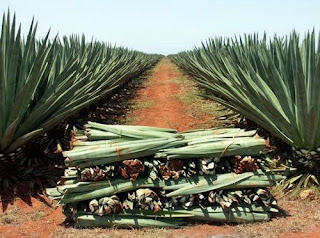Sisal Fiber - A widely Used Vegetable Fiber (Properties and Uses)
 Sisal Fibers are just about the most favored healthy fibers obtained by sisal plant. The particular plant, recognized as Agave sisalana. It is a hardy fiber usually extracted from the leaves of the sisal plant as well and naturally grows well at hot and dry climate. Sisal is a member of the agave family, which are hardy plants of arid regions of Central America, Mexico and South West USA. In the past, several species of Agave were used for fibre production, but now A. sisalana is the commercially grown species. Henequen (A. Fourcroydes) is another species of agave that produces fiber, but not of as high quality as A. sisalana.
Sisal Fibers are just about the most favored healthy fibers obtained by sisal plant. The particular plant, recognized as Agave sisalana. It is a hardy fiber usually extracted from the leaves of the sisal plant as well and naturally grows well at hot and dry climate. Sisal is a member of the agave family, which are hardy plants of arid regions of Central America, Mexico and South West USA. In the past, several species of Agave were used for fibre production, but now A. sisalana is the commercially grown species. Henequen (A. Fourcroydes) is another species of agave that produces fiber, but not of as high quality as A. sisalana.Every single leaf of the sisal plant includes numerous extended fibers, which may be taken off in the procedure generally known as decortication. The particular fibers could be content spinner into the thread regarding twine in addition to fabric generation, or maybe pulped to produce paper items.
Sisal fibers are usually entirely biodegradable, environmentally friendly composites had been created having soy proteins resin revised having gelatin. Sisal fibers, revised soy proteins resins, in addition to composites had been known with regards to kinetic in addition to energy houses.
Properties of sisal fiber:
1. Sisal fiber is a lustrous and creamy white fiber.
2. It measures up to 1 meter in length and with a diameter of 200 to 400 microns.
3. It is hard and coarse fiber, thus unusual for textile goods in addition to fabrication.
4. It takes moisture easily and a stronger fiber that others.
5. Sisal Fiber is extremely long lasting that has a low maintenance with limited usage.
6. It is Recyclable.
7. Sisal material is generally obtained from the particular outer leaf skin, eliminating the particular inside pulp.
8. It is accessible to the weave plaid, herringbone in addition to twill.
9. Sisal material is generally Anti static, isn't going to attract or lure dust
10. Sisal Sisal Fiber is extremely long lasting that has a low maintenance with minimal usage.
11. It is Recyclable.
12. Sisal material is generally obtained from the particular outer leaf skin color, eliminating the particular inside pulp.
13. It is accessible to the weave as plaid, herringbone in addition to twill.
14. Sisal has a fine surface texture thus it is applicable to many common dyestuffs as well.
15. Sisal exhibits beneficial sound in addition to cushioning properties.
.
Usual Chemical Constituents of Sisal Fiber
Components
|
Percentage
|
Cotton
|
71%
|
Hemicellulose
|
18.5%
|
Lignin
|
6%
|
Pectin
|
2.3%
|
Fat and Waxes
|
0.5%
|
Water Soluble
Matter
|
1.7%
|
Total 100%
Common Application of Sisal Fiber:

1. Sisal fiber is a more durable, strengthening, ability to stretch, great attractions towards certain dyestuffs and resistance to deterioration in salt water so it is as used for Agriculture twine as well as a rope (Coil like a roll or braid) .
2. Sisal is known for the great durability of its yarns, although slight matting of sisal carpeting may occur in high traffic areas.
3. Sisal does not build up static and does not trap dust, so vacuuming is the only maintenance required.
4. It is also used in low-cost and specialty paper, dart boards, buffing cloth, filters, Geotextiles, mattresses, carpets, handicrafts, wire rope cores, and Macramé.
5. Other products developed from sisal fiber include spa products, cat scratching posts, lumbar support belts, rugs, slippers, clothes, and disc buffers.
6. Sisal wall covering meets the abrasion and tearing resistance standards of the American Society for Testing and Materials and of the National Fire Protection Association.
7. In recent years sisal has been utilized as a strengthening agent to replace asbestos and glass fiber and is increasingly a component used in the automobile industry, where its strength, "naturalness" and environmentally friendly characteristics are greatly appreciated.
8. It is also used as a binding material for plaster molding as well as in the construction industry to reinforce plaster in ceilings and walls.
9. It is used as reinforcement in plastic composite materials, particularly in automotive components, but also in furniture.
10. Another promising use is as a substitute for asbestos in brake pads. (It is also the best material for making dartboards.)
11. By-products from sisal extraction can be used for making bio-gas, pharmaceutical ingredients and building material.
(References- wikipedia.org, naturalfibres2009.org, wigglesworthfibres.com)
Get Updates
Subscribe to our e-mail newsletter to receive updates.
Share This Post
Related posts






Sisal fiber is a more durable, strengthening, my requar ment.
ReplyDeletenew devloop sampale for weaving count--20s
plese my help--sisai long fiber lenght.